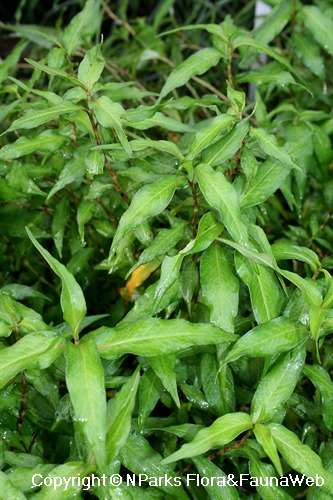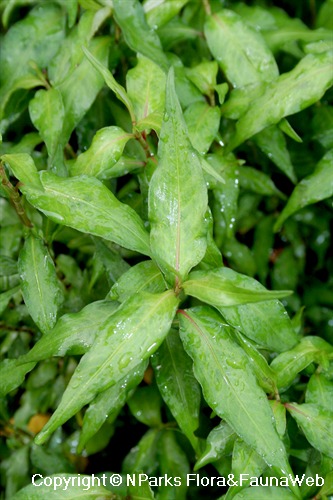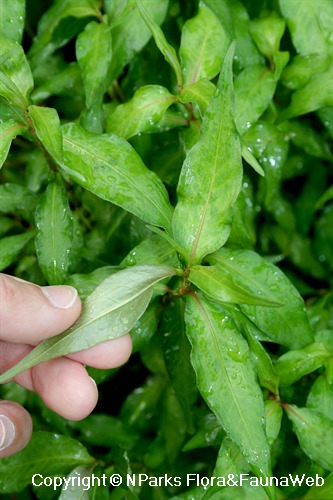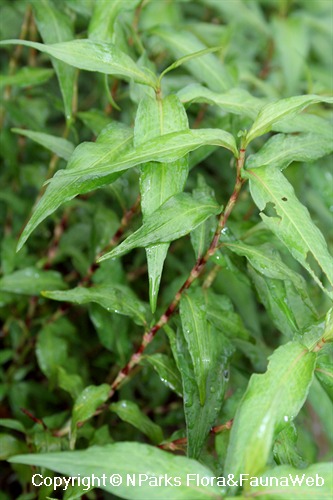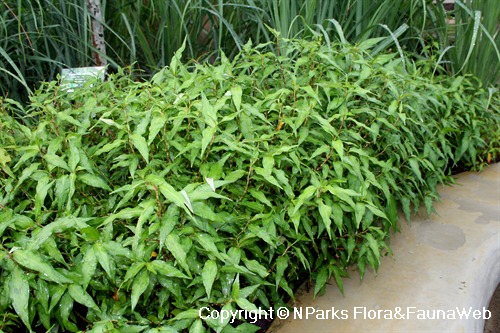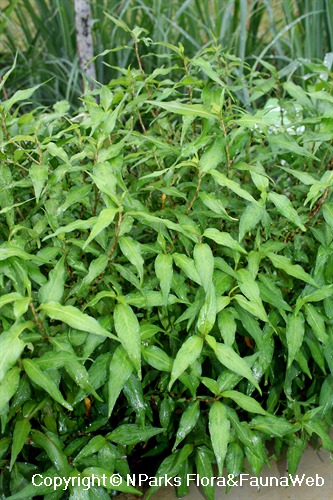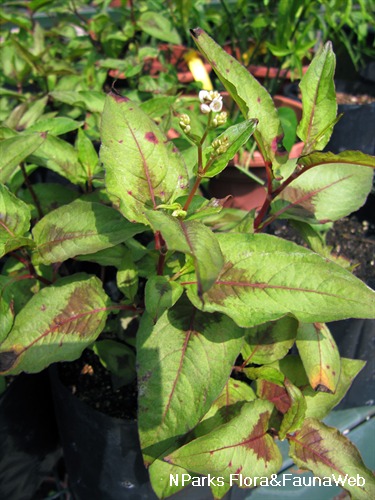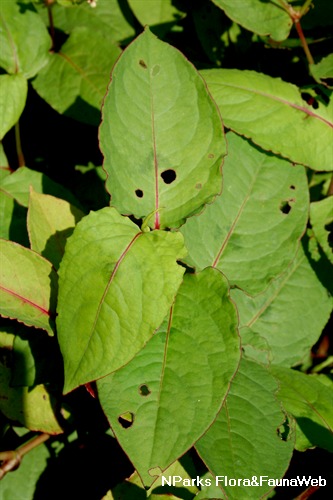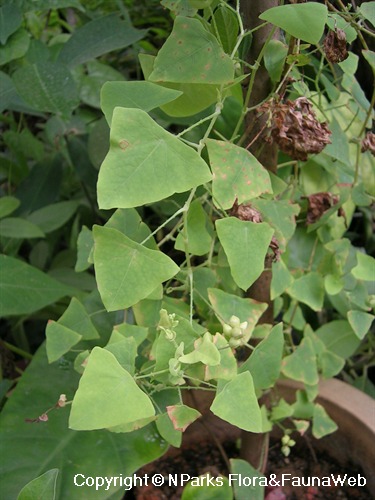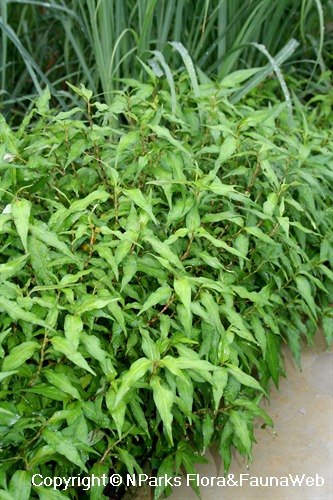
Back
Persicaria odorata (Lour.) Sojak
| Family Name: | Polygonaceae |
| Synonyms: | Polygonum odoratum Lour. |
| Common Name: | Laksa Leaf, Laska Plant, Daun Kesum, Daun Laksa, Vietnamese Coriander, 水蓼, 辣蓼草 |
Name
Classifications and Characteristics
| Plant Division | Angiosperms (Flowering Seed Plants) (Dicotyledon) |
|---|---|
| Plant Growth Form | Herbaceous Plant |
| Lifespan (in Singapore) | Perennial |
| Mode of Nutrition | Autotrophic |
| Plant Shape | Shrubby |
Biogeography
| Native Distribution | Indochina (Myanmar, Thailand, Laos, Cambodia, Vietnam, Peninsular Malaysia) |
|---|---|
| Native Habitat | Terrestrial |
| Preferred Climate Zone | Tropical, Sub-Tropical / Monsoonal |
| Local Conservation Status | Non-native |
Description and Ethnobotany
| Growth Form | Perennial herb up to 0.35 m tall. |
|---|---|
| Foliage | The lance-shaped to lanceolate-ovate (intermediate between lance- and egg-shaped) leaves are green with red markings. The margins and veins are lined with long hairs. |
| Stems | The red, grooved stem is about 2-3 mm wide. |
| Flowers | The white to purplish-pink flowers are arranged in a spike inflorescence. |
| Similar | In the horticultural literature, this species is sometimes confused with Persicaria hydropiper, but these are 2 separate species. |
| Cultivation | This species grows best in well-drained soil that is kept consistently moist. It can also be grow indoors in a sunny windowsill. |
| Ethnobotanical Uses | Edible Plant Parts : Edible Leaves, Edible Stems, Edible Seeds Food (Herb or Spice): In Singapore, the leaves are used to add flavour to the popular laksa dish (a spicy noodle soup in a coconut milk or sour asam base). This herb is especially popular in Vietnamese cuisine where it is added to salads, seafood, duck eggs, and turtle/ frog dishes. The flavour has been described as a blend of lemon and coriander with a radish aftertaste. Medicinal: The juice is taken internally to treat snake bites. |
Landscaping Features
| Desirable Plant Features | Fragrant (Flowers, Foliage, Fruits, Stems, Bark, Roots) (Time Independent, Day) |
|---|---|
| Landscape Uses | Container Planting, Flowerbed / Border |
| Thematic Landscaping | Water Garden, Economic Garden, Naturalistic Garden |
| Usage Hazard - Cons | Irritant - Sap |
| Usage Hazard - Cons Remarks | Oily exudates produced in multicellular glands can cause skin irritation, hence the common name Smartweed. |
Plant Care and Propagation
| Light Preference | Semi-Shade, Full Sun |
|---|---|
| Water Preference | Lots of Water |
| Plant Growth Rate | Moderate |
| Rootzone Tolerance | Waterlogged Soils (Drains Site), Disease / Pest Resistant, Fertile Loamy Soils |
| Maintenance Requirements | Moderate |
| Propagation Method | Seed, Stem Cutting |
Foliar
| Foliage Retention | Evergreen |
|---|---|
| Mature Foliage Colour(s) | Green |
| Mature Foliage Texture(s) | Thin |
| Foliar Type | Simple / Unifoliate |
| Foliar Arrangement Along Stem | Alternate |
| Foliar Attachment to Stem | Petiolate |
| Foliar Shape(s) | Non-Palm Foliage (Ovate, Lanceolate) |
| Foliar Venation | Pinnate / Net |
| Foliar Margin | Entire |
| Foliar Apex - Tip | Acuminate, Obtuse |
| Foliar Base | Attenuate |
| Typical Foliar Area | Microphyll ( 2.25cm2 - 20.25 cm2 ) |
| Leaf Area Index (LAI) for Green Plot Ratio | 4.5 (Shrub & Groundcover - Dicot) |
Non - Foliar and Storage
| Stem Type & Modification | Herbaceous |
|---|---|
| Root Type | Underground (Fibrous Root) |
Floral (Angiosperm)
| Flower & Plant Sexuality | Bisexual Flowers |
| Flower Colour(s) | Pink, White, Purple |
|---|---|
| Flower Grouping | Cluster / Inflorescence |
| Flower Location | Axillary |
| Inflorescence Type | Spike |
| Flowering Habit | Polycarpic |
Fruit, Seed and Spore
| Mature Fruit Colour(s) | Brown |
|---|---|
| Fruit Classification | Simple Fruit |
| Fruit Type | Indehiscent Dry Fruit , Nut / Nutlet |
Image Repository
Others
| Master ID | 1915 |
|---|---|
| Species ID | 3207 |
| Flora Disclaimer | The information in this website has been compiled from reliable sources, such as reference works on medicinal plants. It is not a substitute for medical advice or treatment and NParks does not purport to provide any medical advice. Readers should always consult his/her physician before using or consuming a plant for medicinal purposes. |

